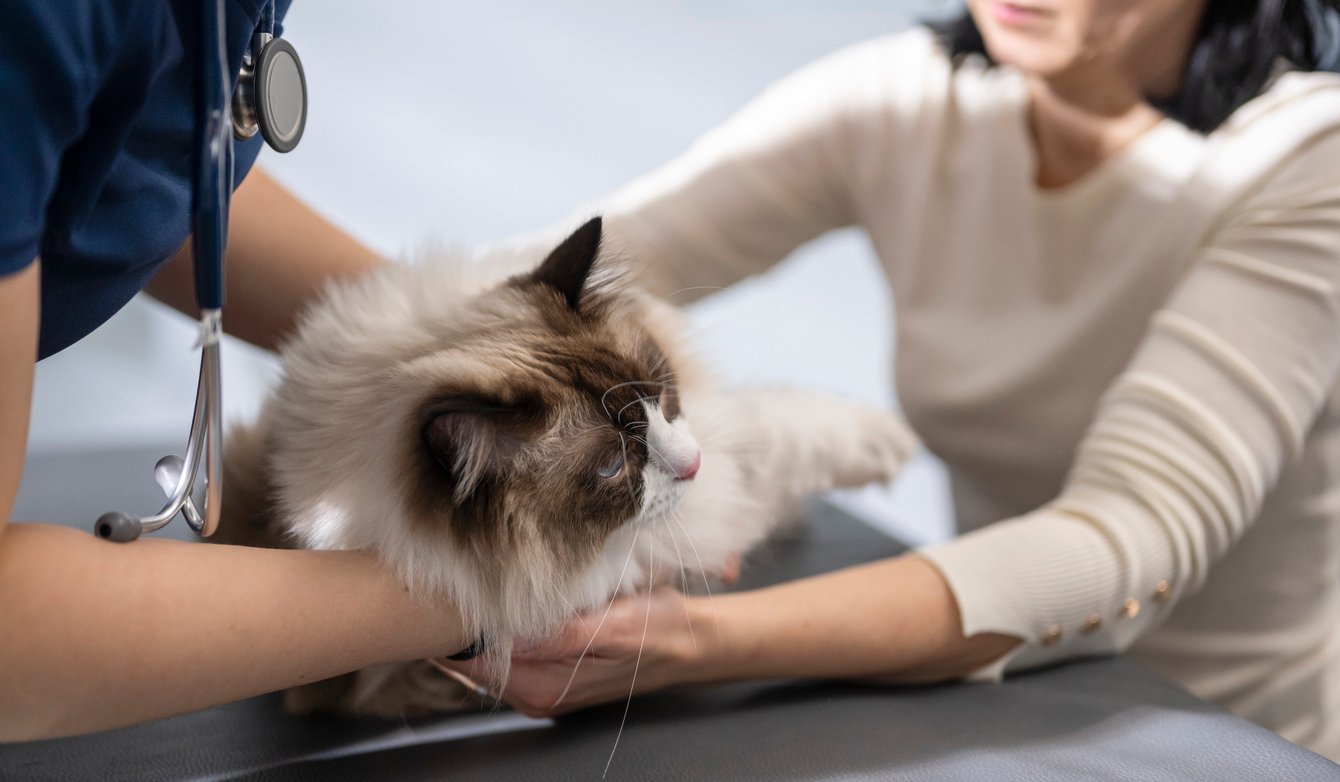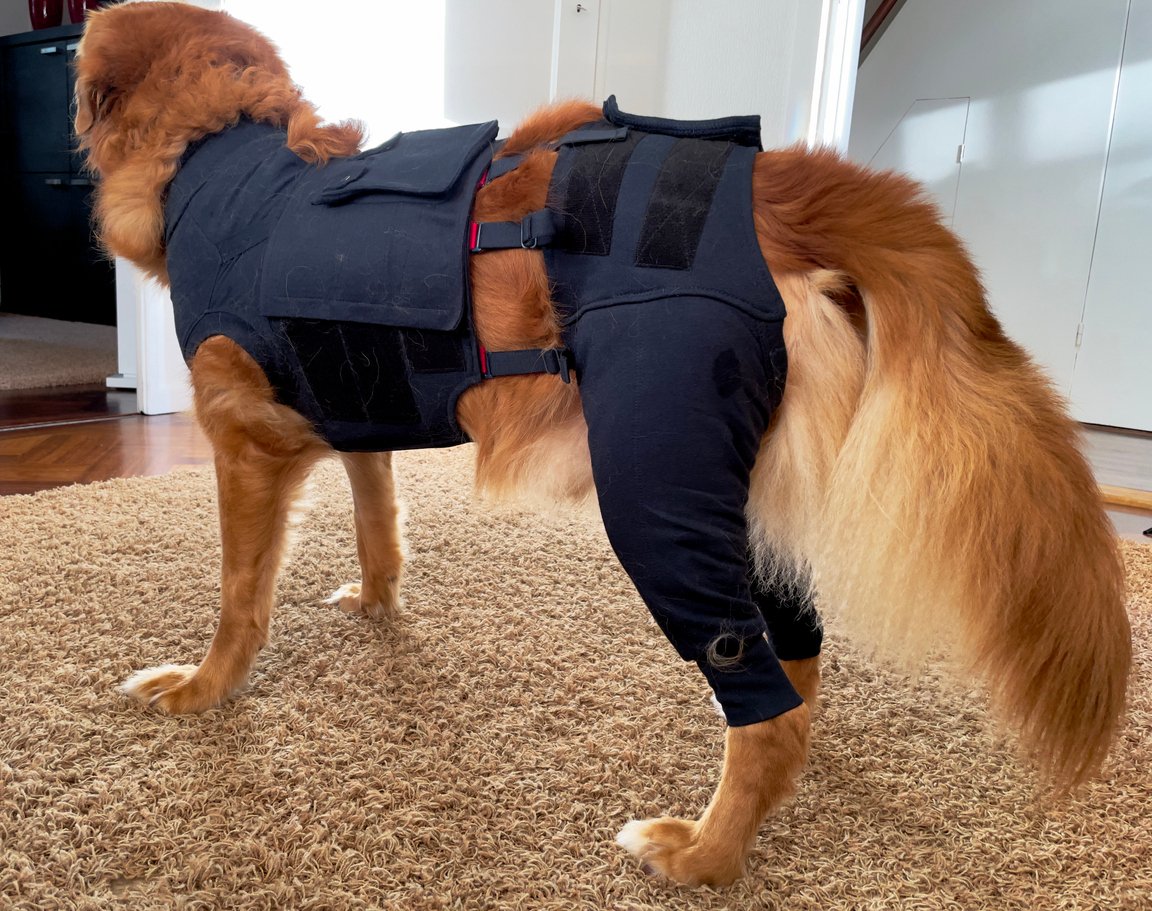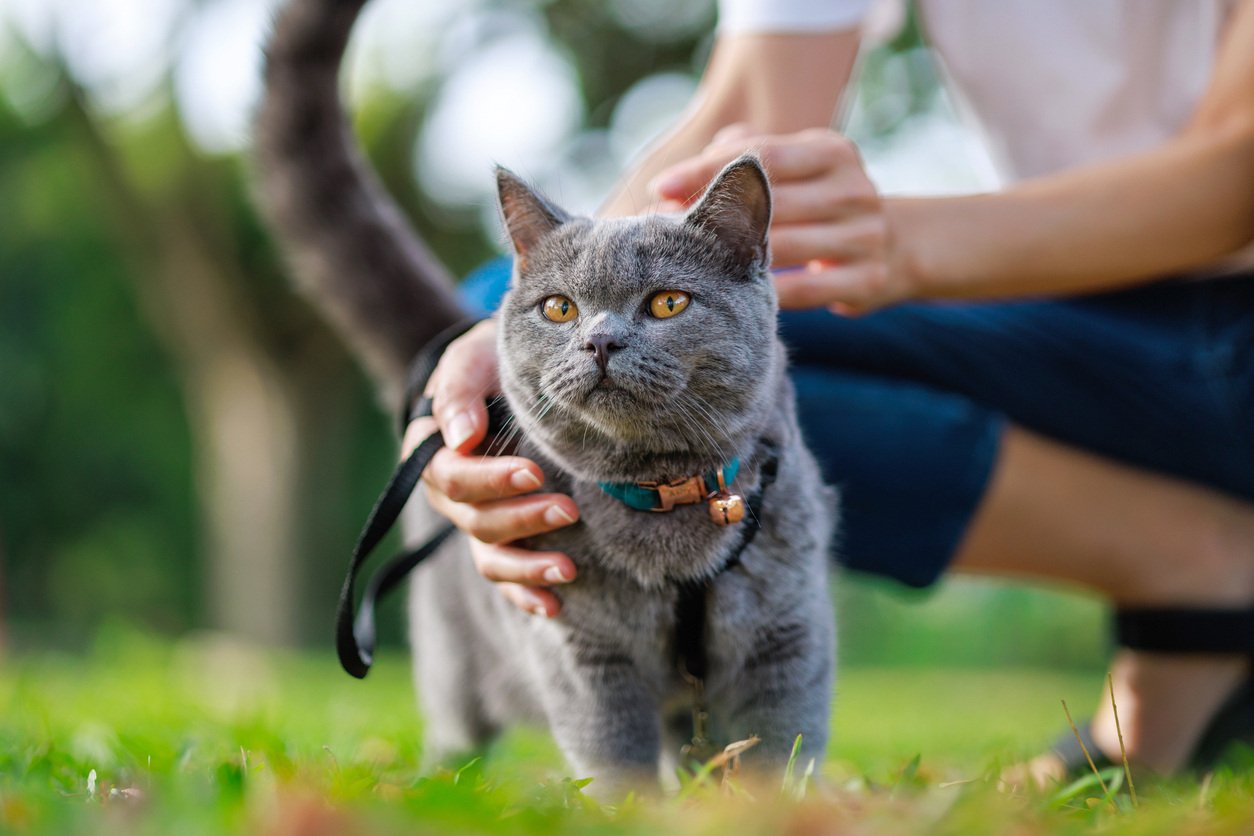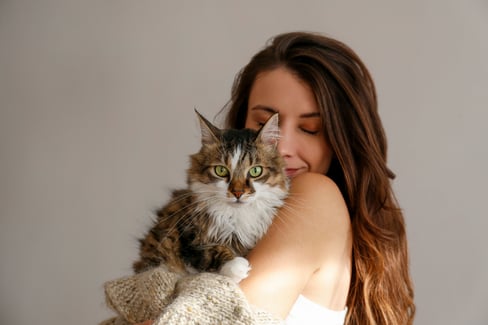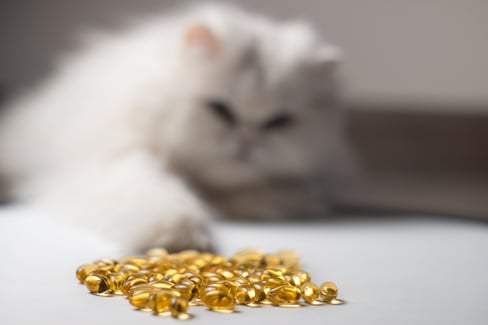Table of Contents
Cats are known for their independence, curiosity, and resilience, but they’re also experts at concealing pain or discomfort. In the wild, hiding illness is a survival tactic; at home, it can make it tricky for cat owners to recognize when something’s wrong. If your usually energetic and feisty feline seems off, it might not just be a weird mood—there could be an underlying cat health issue that needs your attention, and possibly even a veterinarian.
This comprehensive sick cat guide will help you decode the subtle signs of illness in your cat, understand potential causes, and learn how to respond effectively. From behavioural changes, facial expressions to watch out for, and emergency red flags, we’ll cover everything you need to know to keep your furry companion happy and healthy.How to Tell if Your Cat is Sick
It can sometimes be tough to tell if your cat is actually sick, especially enough for a vet visit. Cats will naturally try to hide their sickness, and it’s for a good evolutionary reason. A sick cat is a liability for the rest of the group in the wild, as they are an easier target for predators looking for a quick snack. A predator will watch for any sign of illness in a potential prey animal because it means that they’ll get an easier meal. Because of this, the rest of the group will often shun or abandon the sick cat, leaving them to fend for themselves. To avoid getting left behind and to protect themselves, cats have evolved to hide their sick cat body language, including signs of pain and illness from their pack and from their owners.
This isn’t great news for cat owners, however. But thankfully, there are some tells that you can observe to make it easier for you to tell if your cat is sick:
1. Feline Grimace Scale
By observing sick cat body language, including the facial expressions of our feline friends, we can get a lot of information about how they are feeling. The feline grimace scale is a great resource to follow to help you tell if your cat isn’t feeling their best.
From the image above, the leftmost image represents a cat that’s feeling good, while the rightmost image represents a sick cat. As you can see, the biggest tells are your kitty’s ears and eyes—the further apart their ears are from each other, the sicker they are. Their eyes will also squint more, and their whiskers will be straight.
|
Indicator |
Healthy Cat (No Pain) |
Mild Pain |
Severe Pain |
|
Ears |
Pointed, upright, and forward-facing |
Slightly droopy, angled outward |
Very droopy, flattened to the sides |
|
Eyes |
Open and alert |
Slightly squinted or partially closed |
Fully squinted or tightly shut |
|
Whiskers |
Relaxed and naturally curved |
Slightly tense, less curvature |
Straight and stiff, pulled forward |
|
Muzzle Appearance |
Relaxed and smooth |
Slightly tense or tightened |
Noticeably strained, furrowed |
|
General Expression |
Calm and content |
Slightly withdrawn or concerned-looking |
Distressed, tense, or pained |
How to Use This Table
- Observe your cat's face when they are relaxed and healthy to understand their baseline expressions.
- Compare their current facial features to the indicators in the table to assess if they might be in pain.
- If your cat shows signs of mild or severe pain consistently, consult a veterinarian promptly.
2. Behavioral Changes
Cats are creatures of habit, so sudden changes in behaviour can be a red flag. If your usually playful kitty becomes lethargic, starts hiding in unusual places, or becomes unexpectedly aggressive, it’s worth paying attention. These behaviors might indicate discomfort, pain, or stress.
For example, a cat that usually greets you at the door but suddenly stays hidden under the bed could be feeling unwell. Similarly, increased vocalization—such as loud meowing or yowling—can also be a sign of distress.
3. Appetite and Weight Loss
A cat’s appetite is a strong indicator of their health. If your cat suddenly starts eating less or stops eating altogether, it’s a warning sign. On the flip side, unexplained weight gain or overeating could also point to health issues, like thyroid problems or diabetes.
Take note of how much food is left in their bowl, and consider keeping track of their weight at home. Even small fluctuations in weight can signal an underlying problem.
4. Vomiting and Diarrhea
While occasional vomiting might not be alarming (cats do get hairballs), frequent or severe vomiting can be a symptom of a bigger issue, like gastrointestinal problems, infections, or poisoning. The same goes for diarrhea, especially if it’s persistent or accompanied by blood.
Monitor your cat’s litter box habits closely. If vomiting or diarrhea lasts more than a day, it’s time to call the vet.
5. Changes in Litter Box Habits
Cats are usually meticulous about their bathroom routines, so any deviations could indicate trouble. Straining to urinate, going outside the litter box, or unusually frequent or infrequent trips could all signal issues such as urinary tract infections, kidney problems, or digestive issues.
This is assuming you haven’t changed anything else about their litter box, like the litter you use, the style of litter box you’re providing to them, or moved the box to a different location, as any of these things can also be a reason why your kitty’s litter box habits have changed.
It’s also always a good idea to pay attention to the consistency of their stools and urine output and consult your vet if anything seems off.
6. Physical Signs
Physical symptoms are often the most obvious signs of illness. Keep an eye out for coughing, sneezing, or nasal discharge, which could indicate respiratory infections. Visible injuries, such as cuts or swelling, may also cause discomfort.
Additionally, check your cat’s coat and skin. A dull, patchy coat or excessive scratching can be signs of skin infections, parasites, or allergies.
7. Cat Sleeping Positions When Sick
Cats sleep a lot, but how and where they sleep can give clues about their health. A sick cat might sleep in unusual positions, like curling into a tight ball or stretching out flat, both of which could indicate discomfort. Cats that are unwell may also seek out hidden or unusual sleeping spots, like closets or under furniture, to avoid being disturbed.
Possible Causes of Illness in Cats
Understanding what might be making your cat sick is essential for addressing their health needs quickly and effectively. Cats can suffer from a variety of illnesses, ranging from mild infections to chronic conditions. Here are some of the most common causes to watch out for:
Common Illnesses
- Upper Respiratory Infections (URIs): Cats can catch "cat colds," which are often caused by viruses like feline herpesvirus or calicivirus. Symptoms include sneezing, nasal discharge, coughing, and fever. These infections are more common in multi-cat households or shelters where viruses can spread quickly.
- Dental Issues: Dental disease is a frequent problem in cats, especially as they age. Gingivitis, tooth resorption, and periodontal disease can cause pain, difficulty eating, and even infections that spread to other parts of the body. Signs include bad breath, drooling, and pawing at the mouth.
Chronic Conditions
- Kidney Disease: Chronic kidney disease (CKD) is common in older cats and can cause symptoms like increased thirst, frequent urination, weight loss, and vomiting. Early diagnosis and management with diet and medication can improve quality of life.
- Diabetes: Cats, especially overweight ones, can develop diabetes. Symptoms include excessive thirst, increased appetite, weight loss, and lethargy. Treatment often involves insulin injections and dietary changes.
- Hyperthyroidism: This condition is caused by an overactive thyroid gland and is common in middle-aged and older cats. Symptoms include weight loss despite an increased appetite, hyperactivity, and vomiting.
- Joint Degradation/Arthritis: Cats can develop arthritis and joint issues at almost the same rate as dogs, and given that cats love to jump and contort their bodies in odd positions, it can seriously affect their quality of life. Giving your cat a joint supplement like TRI-ACTA can help heal their joints and reduce pain, allowing them to move around more freely.
TRI-ACTA H.A. for Pets
Our maximum strength formula is optimally designed to accelerate the formation of cartilage, minimize inflammation, expedite the healing process, and improve joint conditions.
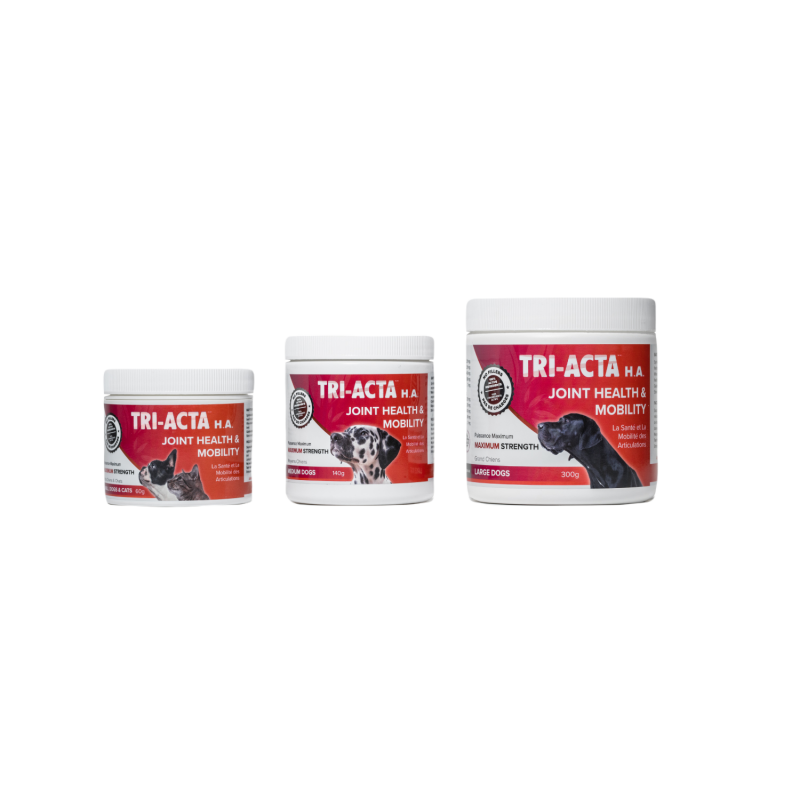
Infections and Parasites
- Fleas and Ticks: External parasites like fleas and ticks not only cause discomfort but can also lead to allergic reactions, anemia, or the spread of diseases. Regular use of vet-recommended preventive treatments can help keep these pests at bay.
- Intestinal Worms: Roundworms, hookworms, and tapeworms are common in cats, especially outdoor ones. Symptoms include weight loss, a bloated belly, and visible worms in their stool or around their rear end. Deworming treatments are effective but require regular administration.
Toxic Ingestions
- Common Household Hazards: Cats are curious creatures, and some of their explorations can lead to accidental poisonings. Common household items like cleaning products, antifreeze, and certain plants (e.g., lilies) can be toxic to cats. Always keep these items out of reach.
- Foods to Avoid: Certain human foods are dangerous for cats, even in small amounts. Chocolate, onions, garlic, grapes, and raisins are toxic and can cause severe health issues. Additionally, avoid giving your cat anything containing alcohol, caffeine, or xylitol, a sweetener found in some sugar-free products.
What to Do If Your Cat Is Sick
If your cat seems under the weather, taking the right steps can make a world of difference. Whether it’s something minor or an issue requiring veterinary care, knowing how to handle the situation will help ensure your feline friend gets the care they need.
Initial Steps
When you first notice that your cat might be sick, the best thing you can do is create a safe and calm environment for them. Cats often hide or withdraw when they’re not feeling well, so isolating them in a quiet room can make observation easier while reducing their stress.
- Observe Symptoms: Keep a close eye on their behavior, appetite, energy level, and bathroom habits. Take note of any changes, such as vomiting, diarrhea, sneezing, lethargy, or unusual vocalizations.
- Check Vital Signs: Feel their nose to see if it’s dry or warm, gently press on their gums to check for healthy pink coloring, and monitor their breathing for any irregularities.
Isolation not only helps you monitor your cat but also prevents the spread of potential illness to other pets.
When to Visit the Vet
While some symptoms in cats may be mild and resolve with at-home care, there are situations where prompt veterinary attention is critical. Cats are experts at masking their discomfort, so recognizing the signs of serious illness is essential. Below are detailed red flags that indicate it’s time to contact a veterinarian or emergency animal clinic.
Red Flags for Emergency Care
These symptoms require immediate attention, as they could indicate life-threatening conditions:
|
Symptom |
What to Look For |
Possible Causes |
|
Difficulty Breathing or Panting |
Open-mouth breathing, wheezing, rapid or labored breathing, blue or pale gums |
Respiratory infection, asthma, heart disease, fluid in the lungs, or airway obstruction |
|
Persistent Vomiting or Diarrhea |
Vomiting more than three times in 24 hours, blood in stool, or watery diarrhea |
Gastrointestinal obstruction, poisoning, pancreatitis, or severe infection |
|
Blood in Vomit, Stool, or Urine |
Bright red or dark, tarry blood in vomit, feces, or unusual urine color |
Internal bleeding, urinary tract infection, kidney stones, or trauma |
|
Loss of Appetite for More Than a Day |
Refusal to eat food or drink water, weight loss, or visible dehydration |
Dental pain, kidney disease, liver problems, or systemic illness |
|
Sudden Lethargy or Collapse |
Extreme tiredness, unresponsiveness, difficulty standing, or falling over |
Severe dehydration, anemia, shock, heatstroke, or heart problems |
|
Signs of Severe Pain |
Yowling, hissing, growling, hiding excessively, or reluctance to move |
Injury, arthritis, abdominal pain, or advanced illness |
|
Seizures or Neurological Symptoms |
Tremors, uncontrolled shaking, confusion, or loss of coordination |
Toxins, epilepsy, head trauma, or neurological disorders |
|
Swollen Abdomen |
Hard or distended belly, vocalizing when touched, or difficulty lying down |
Bloating, organ swelling, or internal bleeding |
|
Unusual Gait or Paralysis |
Dragging limbs, limping, or inability to walk |
Spinal injury, stroke, or advanced arthritis |
|
Persistent Coughing or Sneezing |
Repeated episodes of coughing or sneezing, especially with discharge |
Respiratory infection, asthma, or heartworm disease |
What to Do in an Emergency
- Act Quickly: Contact your veterinarian or the nearest emergency clinic as soon as you notice any of these symptoms. Provide them with a detailed description of your cat’s condition.
- Transport Safely: Keep your cat calm and comfortable during transport. Use a secure carrier and avoid handling them excessively to prevent further stress or injury.
- Prepare Information: Bring any relevant medical records, a list of recent symptoms, and details of any potential toxins or harmful substances your cat may have been exposed to.
Home Care Tips
For non-urgent illnesses, there are several ways you can provide comfort and support for your cat at home:
- Hydration: Make sure your cat stays hydrated by encouraging them to drink fresh water. If they’re reluctant, you can offer wet food or use a syringe (without a needle) to gently give them water. Dehydration can quickly worsen their condition.
- Nutrition: If your cat isn’t eating, try warming up their food to make it more aromatic, or offer plain, cooked chicken to tempt their appetite. Avoid force-feeding unless instructed by a vet.
- Calm Environment: Keep the room quiet and dimly lit to reduce stress. Provide a warm, cozy bed for them to rest, and avoid handling them excessively, as this may irritate or exhaust them further.
- Monitor Progress: Keep a log of their symptoms and behavior to track any changes. This information will be helpful if you need to visit the vet.
Preventive Measures to Keep Your Cat Healthy
Taking steps to prevent illness is always better than treating it after the fact. By incorporating regular care routines and maintaining your cat’s well-being, you can help them lead a long, healthy, and happy life. Here are some key preventive measures to prioritize:
1. Regular Veterinary Check-Ups
Routine visits to the vet are crucial for catching potential health issues before they become serious. Cats are masters at hiding discomfort, so early detection through regular check-ups can make all the difference.
- Why Early Detection Matters: During a vet visit, your cat will receive a thorough physical exam, and any subtle signs of illness—like weight loss, abnormal heart rhythms, or early dental disease—can be identified. These visits allow for proactive treatment, reducing the risk of complications down the line.
Annual wellness exams (or biannual for senior cats) should include blood work, dental checks, and discussions about their behavior and lifestyle.
2. Vaccination and Parasite Control
Keeping your cat protected against infectious diseases and pests is a cornerstone of preventive care.
- Core Vaccines: Essential vaccines, such as those for feline herpesvirus, calicivirus, and feline panleukopenia (FVRCP), as well as rabies, are recommended for all cats. Your veterinarian may also suggest additional vaccines based on your cat’s lifestyle, like those for feline leukemia virus (FeLV).
- Parasite Prevention: Regular treatments to control fleas, ticks, and intestinal parasites are vital for keeping your cat comfortable and disease-free. Even indoor cats can be exposed to parasites, so consult your vet about the best schedule for preventatives.
Maintaining a vaccination and parasite prevention routine is key to safeguarding your cat against avoidable health risks.
3. Healthy Diet and Hydration
What your cat eats plays a major role in their overall health and well-being.
- Tailored Nutrition: Every cat is different, so their diet should match their age, activity level, and health needs. For example, kittens need food rich in calories and nutrients to support growth, while senior cats may require a diet lower in calories but higher in joint-supporting ingredients like omega-3s.
- Hydration: Cats often don’t drink enough water on their own, which can lead to urinary and kidney issues. To encourage hydration, offer fresh water daily and consider adding wet food to their diet for extra moisture.
- Incorporating Joint Supplements: As many as 60–90% of older cats have osteoarthritis. Giving your cat joint supplements, ideally starting as early as possible in their life, can significantly reduce how much they suffer from this disease. TRI-ACTA joint supplements contain two types of glucosamine formulated for cats and chondroitin sulfate for maximum benefit to the joint tissues (including cartilage regeneration and repair), Methylsulfonylmethane (MSM, a natural anti-inflammatory), and in our extra-strength version (TRI-ACTA H.A.), hyaluronic acid (helps with joint lubrication). The supplements also contain 100% active ingredients and are a certified Canadian veterinary health product.
Regularly monitoring your cat’s weight and adjusting their diet as needed can prevent obesity, which is a leading contributor to chronic health conditions like diabetes and arthritis.
Conclusion
Caring for a sick cat requires observation, patience, and sometimes quick action. By understanding the signs of illness and injury, knowing when to seek veterinary help, and providing the right care at home, you can make a significant difference in your cat’s recovery from sickness and help maintain their overall well-being.
Taking preventive measures, such as regular vet visits, vaccinations, and proper nutrition, are your best defence against many health problems that your cat may experience. Cats may not always tell you when something’s wrong, but by staying attentive and proactive, you can ensure your feline friend enjoys a long, vibrant life by your side. Your cat depends on you, and with the right knowledge and care, you’ll be ready to support them through anything.
One of the easiest and most important preventative measures you can take for maintaining your cat’s health is giving them joint supplements. With powdered versions, it’s easy enough to sprinkle the supplement on your cat’s regular food. Flavourless options like TRI-ACTA ensure that the palatable nature of your cat’s food isn’t affected. Chances are they won’t even notice it!
Purchase TRI-ACTA online or learn where to buy at a store near you.
TRI-ACTA H.A. for Pets
Our maximum strength formula is optimally designed to accelerate the formation of cartilage, minimize inflammation, expedite the healing process, and improve joint conditions.

Newsletter Signup
Subscribe to our newsletter to receive the latest news and exclusive offers.
.jpg?height=2000&name=Cliick_Integricare-DISPLAY-REVISEDV2%20(1).jpg)
Proactive & Therapeutic Joint Supplements
When given daily, Integricare joint supplements recover bone and joint injuries faster and help prevent mobility injuries from happening in the first place.

